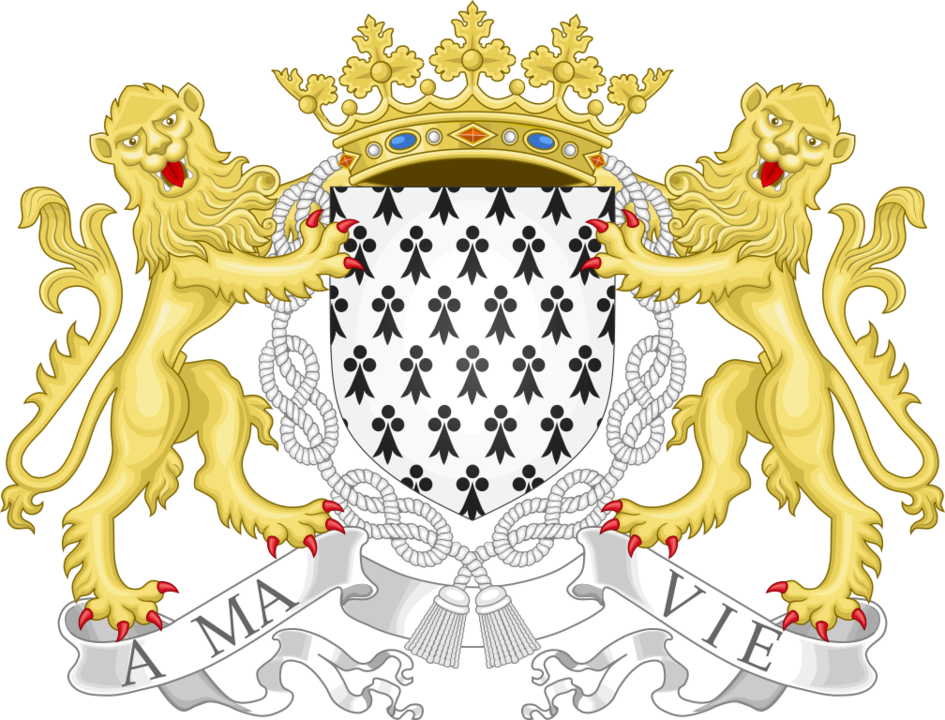Map of the feudal coins of “France”
N.B.: It is true that the name “France” here is something of a misnomer. During the period in question, the Kingdom of France was either forming or in its early years and its borders fluctuated immensely due to the fragmentation of the Carolingian Empire and, later, its strategically important location lodged between England and the Holy Roman Empire.
As the Early Middle Ages unfolded, the Western Roman Empire had fallen, the Kingdom of France did not yet exist, and the Carolingians took the throne with Pepin the Short starting the show, followed soon after by Charlemagne, coinage was about to undergo major upheaval.
Thanks to the capitularies of Vernon in 755 and Frankfurt in 794, the Carolingians regulated currency and granted themselves exclusive minting rights. A little later, in 864, it was Charles the Bald who introduced the type that would inspire numerous coins with the Carolingian monogram on the obverse and the unmistakable cross pattée on the reverse.
Coin France
Charles le Chauve, Obol, Melle, AU(55-58), Silver, Prou:704-705
The birth of feudal coinage
However, as royal political power waned little by little, during the 10th century, each duchy, county, seigneury, and even bishopric began to issue its own currency.
When Hugh Capet became king in 987, it proved difficult for him to enforce the exclusive right to mint within the crown lands.
To put it another way and far more prosaically, we were far from universal royal minting and chaos reigned in the mints.
France Medal
Reproduction du Denier Parisis, Philippe Auguste, MS(65-70)
And so began a long and arduous battle between the royal mint and the provincial mints.
It was not until the start of the 13th century, under the impulse of Philip II and subsequently his successors, that the royal mint began bit by bit to take back its rights, to the detriment of the seigniorial mints.
Metal & type
In the early years, these feudal coins (also known as provincial coins) stuck close to the Carolingian type, often copies with more or less deviation.
Then, little by little, the coins evolved and became more “original”. They were personalized and featured a coat of arms here, a portrait there...
Let us also remember that only silver had been in circulation since the end of the 8th century, on the basis of the system established by Charlemagne: livres, sols, and deniers. Gold would not reappear until the reign of Louis IX (Saint Louis). Good news for business! The value system based on the weight of silver held strong and facilitated trade.
Methodology
Although it would be very complicated to present a complete map due to the length of the historical period covered and the shifting borders, here is an attempt, with coins from multiple periods, to provide you with a geographical and non-exhaustive overview of these feudal coins.
This overview will be based on a map from 1180 (the coins presented may be from different periods), just as Philip II took the throne. A detailed description of each coin featured is included below the map.
Some counties (Foix, Narbonne...), viscounties, many archbishoprics, etc., are missing, but we have tried to show the main ones.
List

Duchy of Brittany
The Duchy of Brittany was a feudal duchy from 939 to 1547 and notably a crucial prize in the long battle between the two rivals the Kingdom of France and the Kingdom of England. It emerged following the liberation from the Viking occupation and joined the Kingdom of France permanently in 1532. The last duke, Henry II, acceded to the French throne in 1547.
This coin was issued by John IV of Brittany, who was duke from 1365 to 1399 and an ally of England and notably the Black Prince in the midst of the Hundred Years’ War.
Coin France
Bretagne, Jean IV de Montfort, 1/2 Gros, 1345-1399, VF(30-35)
Duchy of Normandy
The Duchy of Normandy was a feudal state created following the Viking invasion. In 911, the French king, Charles the Simple, granted the territory to Rollo, one of the Viking chiefs. The duchy was dissolved by Louis XI in 1469.
This coin was issued by Richard I of Normandy, known as Richard the Fearless and grandson of Rollo, who was duke from 943 to 996.
Coin France
Normandie, Richard Ier, Denier au temple, 970-980, Rouen
County of Maine
The County of Maine was founded in the 9th century and annexed to the crown lands by Philip II in 1204. Following that, the County of Maine was traditionally given to the king’s first son.
This silver denier was issued by Herbert I (Wakedog), count from 1015 to 1032.
Coin France
Herbert I, Denier, ND (1015-1246), Le Mans, Immobilized type
County of Anjou
The County of Anjou began to make a name for itself in the 10th century, when the Carolingian Empire was no more, on the ruins of West Francia. Philip II recovered it in 1204 and made it his vassal. It was raised to a duchy at the beginning of the Hundred Years’ War.
Here we have an obol issued by Charles of Valois, founder of the dynasty of the same name and King of Aragon, who acquired the County of Anjou in 1290 through his marriage to Margaret of Anjou.
County of Tours
The County of Tours was created in the 9th century during the reign of the Carolingian king Louis the Pious. It was placed under the tutelage of the County of Anjou in 1044 and recovered by Philip II in 1204.
Here is a silver denier issued by the abbey of Saint Martin of Tours, which had been minting coins since the 10th century.
Coin France
Touraine, Denier, 1150-1200, Saint-Martin de Tours, EF(40-45)
Duchy of Aquitaine
Its first constitution dates to 675 and the death of Childeric II. It was renamed the Duchy of Guienne in 1259 and was held in the crossfire between England and France during the Hundred Years’ War, at the end of which, in 1453, it was annexed to the crown lands.
This silver hardi was issued by the duke and – incidentally (!) – King of England Henry IV, V, or VI, during the first half of the 15th century.
County of La Marche
The County of La Marche was one of the fiefs of the Duchy of Aquitaine. It was acquired by the crown lands in 1525. This silver denier was issued by Hugh IX of Lusignan, known as “Le Brun” (the Brown). Allied with the English, he was Count of La Marche from 1199 to 1219 thanks to the goodwill of Richard the Lionheart.
Coin France
La Marche, Hugues IX, Denarius, VF(20-25), Silver, Boudeau:437
County of Poitou
Created by Charlemagne in 778, the county was also one of the fiefs of the Duchy of Aquitaine. It was recovered by Philip II in 1202 and annexed to the crown lands, but by no means once and for all. The county passed from hand to hand over the centuries before finally returning to the crown lands in 1422, when its last count became King Charles VII.
This silver obol was struck by the Melle mint, which was in operation from the 9th to the 12th century. The types are always relative to the deceased Carolingian king Charles II the Bald, whatever the period.
County of Toulouse
Just like the County of Poitou, the County of Toulouse was also founded by Charlemagne in 778. It returned to the bosom of the crown lands in 1361 thanks to John II (the Good). This silver denier was issued by the Count of Toulouse Alfonso Jordan at the beginning of the 12th century.
County of Provence
In 843, the County of Provence belonged to the Middle Francia of Lothair I. In 1487, it returned to France and the king became Count of Provence.
This denier shows Charles I of Anjou, Count of Provence by alliance through his marriage to Beatrice of Provence in 1246. Among other things, he was also King of Naples and Sicily and, incidentally, a brother of King Louis IX, no less!
Coin France
Provence, Denarius, Marseille, EF(40-45), Silver, Boudeau:814
Bishopric of Clermont (County of Auvergne)
The lands of the County of Auvergne played host to the Council of Clermont organized by Pope Urban II in 1095. Here we have a stunning denier struck by the bishopric and dating from the very start of the 11th century.
Bishopric of Clermont Anonymous
Denarius, 1030-1060, Clermont, Silver
Duchy of Burgundy
The Duchy of Burgundy emerged in the 10th century from the ruins of the Carolingian Empire and would become extremely powerful during several centuries. It was not until the end of the 15th century that Louis XI integrated it into the crown lands.
This silver denier was issued by Hugh IV, Duke of Burgundy from 1218 to 1272. He notably accompanied Louis IX on the Seventh Crusade.
County of Nevers
Created in the 10th century, the county had relatively little independence over the course of time and was recovered by the Duchy of Burgundy in the 14th century. It became a duchy in the 16th century. This silver denier was issued by Mathilda II, Countess of Nevers from 1257 to 1262.
County of Blois
An ancient territory, the County of Blois was likely created by the Franks around the 6th century. It was Louis the Pious who made the status of the County of Blois official in 832. Integrated into the Duchy of Orleans at the end of the 14th century, it was at the end of the 15th century that Louis XII absorbed it back into the crown lands.
This billon obol from Blois was issued during the reign of Count Hugh I.
County of Périgord
No count coinage here, this one being later, with this silver denier dating from the 10th century struck in the name of the King of the French Louis IV, known as “d'Outremer” (from overseas).
Coin France
Périgord, Anonymous, Denarius, AU(50-53), Silver, Boudeau:451
Bishopric of Maguelonne (County of Melgueil)
Located on the lands of the County of Maguelonne (or Maguelone), then in the County of Melgueil. The coastal island of Maguelonne having been destroyed by Charles Martel in 737, counts and bishops took refuge in Substantion, then in Melgueil. The county and the bishopric were ceded by Peter I of Melgueil, as a fief, to Pope Urban II in 1085.
Coin France
Languedoc, Anonymous, Denarius, EF(40-45), Billon, Boudeau:753
Viscounty of Bearn
The viscounty was created in the 10th century following the division of the Duchy of Gascony and remained autonomous until 1290. The last count having died without a male heir and his daughter having married the Count of Foix, Gaston III, known as Fébus, the viscounty passed to his control.
The silver denier presented below was issued by the Centule dynasty.
Translated from the French by: Michael Wright
Cartography :
https://commons.wikimedia.org/wiki/File:Map_France_1180-fr.svg
Coat of arms :
Duchy of Brittany - Sodacan, Glasshouse and Heralder — Travail personnel, CC BY-SA 4.0, https://commons.wikimedia.org/w/index.php?curid=83572090
Sources :
- https://books.google.fr/books?id=C7EOAAAAQAAJ&pg=PR3&hl=fr&source=gbs_selected_pages&cad=3
- https://www.persee.fr/doc/minf_0398-3609_1909_num_38_1_1132
- https://cours-de-droit.net/organisation-seigneurie/
- https://www.sacra-moneta.com/sacramon/monnaies-medievales.html
- https://fr.wikipedia.org/wiki/Numismatique_m%C3%A9di%C3%A9vale
- https://fr.wikipedia.org/wiki/Hugues_Capet
- https://fr.wikipedia.org/wiki/Philippe_II_Auguste
- https://fr.wikipedia.org/wiki/Empire_carolingien
- https://fr.wikipedia.org/wiki/Haut_Moyen_%C3%82ge
- https://fr.wikipedia.org/wiki/Royaume_de_France
- http://graphikdesigns.free.fr/bearn-histoire-moyen-age.html

















































